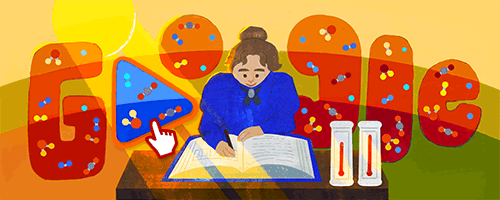#eunice newton foote
Text



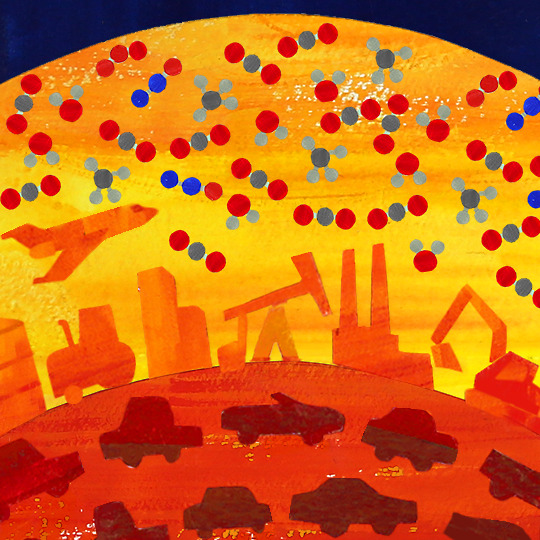


I got to work on today's Doodle celebrating Eunice Newton Foote! She was the first to make the connection between specific gases and global warming. ☀️ It's made out of cut paper and gouache, put together in Animate. You can click through the whole thing [here!]
732 notes
·
View notes
Text
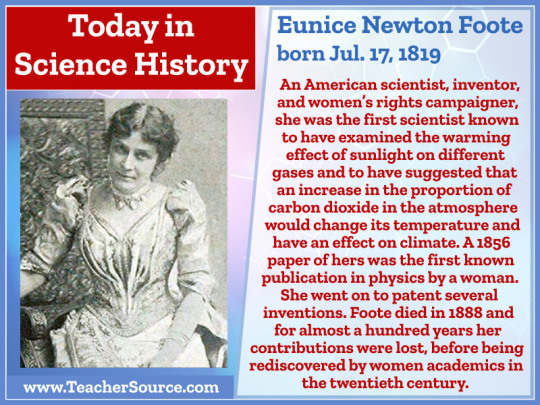
Eunice Newton Foote was born on July 17, 1819. An American scientist, inventor, and women's rights campaigner, she was the first scientist known to have examined the warming effect of sunlight on different gases and to have suggested that an increase in the proportion of carbon dioxide in the atmosphere would change its temperature and have an effect on climate. A 1856 paper of hers was the first known publication in physics by a woman. She went on to patent several inventions. Foote died in 1888 and for almost a hundred years her contributions were lost, before being rediscovered by women academics in the twentieth century.
#eunice newton foote#inventors#greenhouse gases#climate change#women in science#women in history#science#science history#science birthdays#on this day#on this day in science history
19 notes
·
View notes
Text
By Rachel May
Rachel May, English professor and author, came upon Elizabeth Wagner Reed’s book about a decade ago, on Reed’s daughter’s website.
Published April 22, 2023Updated April 24, 2023, 10:50 a.m. ET
This article is part of Overlooked, a series of obituaries about remarkable people whose deaths, beginning in 1851, went unreported in The Times.
In 1992, the geneticist Elizabeth Wagner Reed self-published “American Women in Science Before the Civil War,” a book highlighting 22 19th-century scientists. One of them was Eunice Newton Foote, who wrote a paper on her remarkable discovery about greenhouse gases, “a phenomenon which is of concern to us even now,” Reed wrote.
Foote was forgotten soon after the paper was read aloud by a male scientist at a conference in 1856 and published the following year. A male scientist was eventually credited with the discovery.
Like Foote, Reed herself fell into obscurity, a victim of the erasure of female scientists that the historian Margaret Rossiter coined the Matilda Effect — named for the sociologist Matilda Joslyn Gage, whose 1870 pamphlet, “Woman as Inventor,” condemned the idea that women did not have the skills to succeed in the field.
Reed, however, made significant contributions to the sciences.
She wrote a landmark study about intellectual disability genetics, helped found a field of population genetics and wrote many more papers on botany, the biology of women and sexism in science.
Reed persisted in her research even when she found herself a widow with a toddler during World War II. By the time of her death, in 1996, in spite of publishing more than 34 scholarly papers, public school curriculums and two books, the record didn’t bend in her favor. It wasn’t until 2020, when the scientist and scholar Marta Velasco Martín published a paper on Reed, that her legacy was resurrected.
Reed was born Elizabeth Wagner on Aug. 27, 1912, in Baguio, in what was then called the Philippine Islands, to Catherine (Cleland) and John Ovid Wagner. John was from Ohio and worked in construction there at the time; Catherine, from Northern Ireland, was working in the Philippines as a nurse.
The family later settled on a farm in Ohio, where Elizabeth grew up picking raspberries “from dawn to dusk,” her son William Reed said in a phone interview.

“She learned how to work really hard,” he added. “I remember her saying how much she loved school, partly because it wasn’t doing farm work.”
At the end of one summer, he said, she used some of her earnings to buy a book about wildflowers in Ohio — “her first purchase was a scientific book.”
She would go on to cultivate wildflowers in her backyard as an adult, volunteer at a wildflower arboretum in Minnesota and write about botany in scientific articles and in educational materials for children. Reed’s daughter, Catherine Reed, told Martín that her mother “loved nature, especially plants, and, wanted to be a scientist from a very early age.”
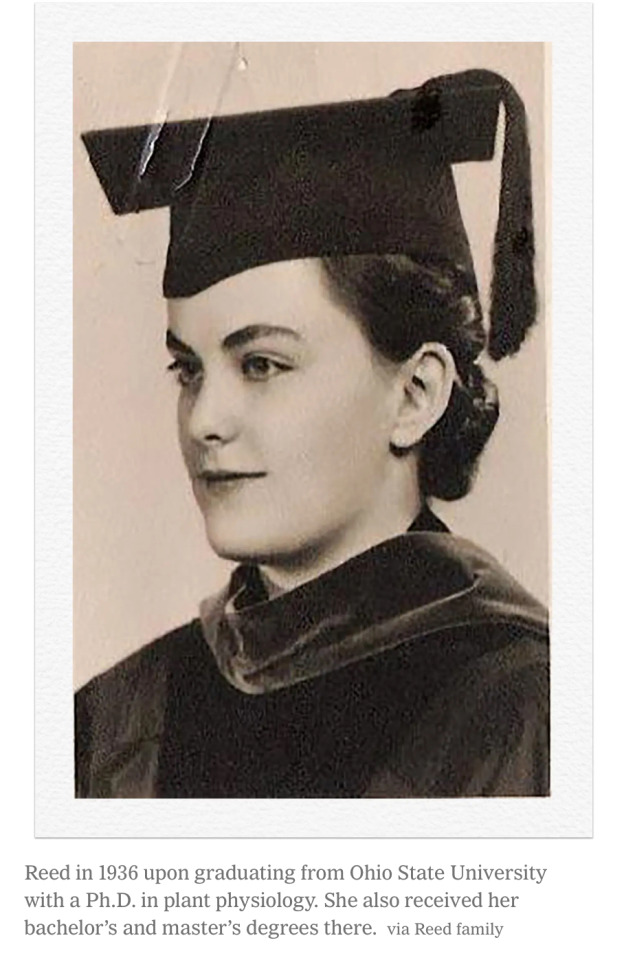
In 1933, Reed earned her bachelor’s degree at Ohio State University, where she also earned a master’s in 1934 and a Ph.D. in plant physiology in 1936. She put herself through school with a scholarship and by washing dishes and working in the cafeteria. In 1939 and 1940, she published her first two papers, one about the effects of insecticides on bean plants and the other about how various types of dusts affect the rate of water loss in yellow coleus plants by night and day.
In 1940, she married a fellow scientist, James Otis Beasley, and had a son, John, with him just after James left to fight in World War II in 1942. When her husband was killed in the war the next year, she supported herself and her son by teaching at five different universities. “The first part of her life,” William Reed said, “was sheer determination.”
She began working with the geneticist Sheldon C. Reed, whom she married in 1946, and together they helped found the field of Drosophila population genetics, which uses fruit flies as a simple and economical method of studying genetics in a laboratory while offering important insights into similar species.
Soon after, the couple moved to Minnesota, where Sheldon was hired as the director of the Dight Institute of Human Genetics at the University of Minnesota in Minneapolis. Elizabeth was denied a job at the university, which cited rules against nepotism.
The Reeds went on to write a book about intellectual disabilities that analyzed data from 80,000 people and their families; the study, they said, was “one of the largest genetic investigations so far completed.”
They found that disabilities could be caused by genetic or environmental factors and could therefore be heritable. They also proposed — to controversy that still exists today — that such disabilities were preventable through education of the general public and voluntary sterilization or birth control of potential parents with low I.Q.s.
Though Elizabeth’s name was listed first as author, a letter of acknowledgment calling the couple’s work “truly magnificent” referred to them as “Dr. and Mrs. Reed.”
Reed was quite aware that her husband was receiving more credit, her son William said, but she never let it embitter her. In 1950, however, she published a paper on sexism in the sciences based on her study of 70 women working in the field. It found that marriage and childbirth decreased their productivity and sometimes even dissuaded them from continuing their careers. It led her to mentor women in the field through the advocacy group Graduate Women in Science.
“She was a scientist before it was popular for women to become scientists,” Nancy Segal, a psychologist at California State University known for her study of twins, said in an interview, “and she was a great role model for so many of us women postdocs at the time.”
In writing “American Women in Science Before the Civil War,”Reed corresponded with archivists and scoured card catalogs, journals and proceedings of associations and societies. In addition to recognizing Eunice Foote’s work almost two decades before other scientists did, the book included biographies of, among others, the astronomer Maria Mitchell; Ellen Smith Tupper, who was known as the “Queen Bee of Iowa” for her study of that insect; and the entomologist Mary Townsend.
Reed wrote that it was a testimony to the strengths of these women that they pursued science despite the fact that they were “often denied entry to colleges and unable to attain professional status.”

Reed also supported teaching children about science so that they would have the tools to solve what she called the “current crises of exploding populations and deteriorating environments.” She published papers about teaching proper scientific methods in schools and created curriculums with the University of Minnesota.
“Classrooms always house some living organisms,” she wrote, tongue-in-cheek, in the Journal of the Minnesota Academy of Science in 1969. “In many, unfortunately, all are of a single species, Homo sapiens. The population consists of many immature species (children) and a few adults, usually female (teachers). This makes for a certain homogeneity, but it can be alleviated by introduction of other living species, animal or plant.”
The fact that Reed was, like so many of her predecessors, lost to history is indicative of the pervasive sexism of her era. But women today continue to face hurdles in entering scientific fields. A report from the Massachusetts Institute of Technology this year found that “the underrepresentation of women in the science, technology, engineering, and mathematics (STEM) fields continues to persist,” with women making up only 28 percent of the STEM work force.
Like Reed, her daughter, Catherine, was a scientist, having earned a Ph.D. in ecology, but she ultimately became so disillusioned that she held a ceremonial burning of her degree and instead turned to artwork and championing her mother’s legacy. She published her mother’s book on American women in science on her website in about 2010. She died in 2021 at 73.
Elizabeth Wagner Reed died at 83 on July 14, 1996, most likely of cancer. She recognized her symptoms, but, knowing what the treatments would be like and, to her mind, the probable outcome, she never sought a diagnosis. (Sheldon Reed died in 2003.)
William Reed said there was no joy like taking a walk with his mother, who could describe every plant and animal they passed. She and Sheldon were avid bird-watchers (and occasional polka dancers), and the family spent many vacations at Lake Itasca, Minn., relaxing under old-growth Norway Pines.
Reed’s favorite flower was the showy lady’s slipper, the state flower of Minnesota, an orchid notoriously difficult to cultivate, like the careers of many of the women she wrote about. Its Latin name is Cypripedium reginae, with reginae meaning queen.
#Elizabeth Wagner Reed#Women in science#American Women in Science Before the Civil War#Books for women#Eunice Newton Foote#Margaret Rossiter#Matilda Effect#Matilda Joslyn Gage#Woman as Inventor#Marta Velasco Martín#Graduate Women in Science#Maria Mitchell#Ellen Smith Tupper#Mary Townsend
6 notes
·
View notes
Text
"In a series of experiments conducted in 1856, Eunice Newton Foote — a scientist and women's rights campaigner from Seneca Falls, New York — became the first person to discover that altering the proportion of carbon dioxide (then called "carbonic acid gas") in the atmosphere would change its temperature. This relationship between carbon dioxide and the earth's climate has since become one of the key principles of modern meteorology, the greenhouse effect, and climate science. However, no one acknowledged Foote was the first to make this discovery for more than a century, in large part because she was a woman."
1 note
·
View note
Text
Se non fosse stata una donna l'avremmo ignorata?
204° anniversario della nascita di Eunice Newton Foote! #GoogleDoodle https://g.co/doodle/2jun33q
#scienza#cambiamento#cambiamento climatico#riscaldamento climatico#doodle#google#Newton#eunice newton foote#donne
0 notes
Text
204º Aniversário de Eunice Newton Foote! #GoogleDoodle https://g.co/doodle/2jun33q
1 note
·
View note
Text
Google homenageia Eunice Newton Foote, pioneira da ciência do clima
O Doodle de hoje celebra o 204º aniversário da cientista americana e ativista dos direitos das mulheres, Eunice Newton Foote.
Foote foi a primeira pessoa a descobrir o efeito estufa e seu papel no aquecimento do clima da Terra. Clique no Doodle de hoje para explorar o processo da descoberta científica de Foote!
Foote nasceu neste dia em 1819 em Connecticut. Ela frequentou a Troy Female…
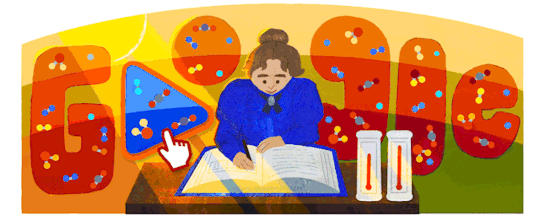
View On WordPress
0 notes
Photo

The first person to discover a link between increased levels of CO2 and #globalwarming was a New Yorker named Eunice Newton Foote. Read her 1856 paper, and how she went unacknowledged for more than a century, here: https://publicdomainreview.org/collection/first-paper-to-link-co2-and-global-warming-by-eunice-foote-1856 #earthday #climatechange
543 notes
·
View notes
Text
Today’s slideshow Doodle celebrates the 204th birthday of American scientist and women’s rights activist Eunice Newton Foote. Foote was the first person to discover the greenhouse effect and its role in the warming of Earth’s climate.
6 notes
·
View notes
Text
Climate
Climate is still controversial? Yes. I’m reminded every time I post a climate story and a denier pops up.
Why do I care about climate? Climate impacts everything. Food chain, jobs, housing, health, animals, plants, etc. I’m saving info so I can find it again. To learn - about trends, land use, natural patterns, and habitats. (I try to be aware of science funded by corporate interests. See Toxic Sludge Is Good For You)
“When Did Climate Science Begin?”
How 19th Century Scientists Predicted Global Warming | Jstor.org
1824 & 1837 Papers by Joseph Fourier, a French mathematician and physicist who spent his career pondering the mechanics and equations governing heat transfer.
1856 Eunice Newton Foote experimented with heat trapping gases (CO2) and wrote a paper for The American Journal of Science. Interesting factoid: “When time came to present her research before the American Association for the Advancement of Science—among the country’s most eminent scientific gatherings—they didn’t allow women to speak, so it was read by a male colleague.”
“Nature changes all the time! Why worry?”
What’s the Difference Between Weather and Climate? | NASA
The difference between weather and climate is a measure of time.
Weather is what conditions of the atmosphere are over a short period of time.
Climate is how the atmosphere "behaves" over relatively long periods of time.
In addition to long-term climate change, there are shorter term climate variations. This so-called climate variability can be represented by periodic or intermittent changes related to El Niño, La Niña, volcanic eruptions, or other changes in the Earth system.
United States Global Change Research Program (USGCRP)
“Thousands of studies conducted by researchers around the world have documented increases in temperature at Earth’s surface, as well as in the atmosphere and oceans. Many other aspects of global climate are changing as well. Human activities, especially emissions of heat-trapping greenhouse gases from fossil fuel combustion, deforestation, and land-use change, are the primary driver of the climate changes observed in the industrial era.”
Climate science is not new. Is not a fad.
The climate scientists are talking - Will we listen?
#climate change#weather#global temperature#earth#science#natural habitat#farm and ranch#gardening#urban planning
3 notes
·
View notes
Photo
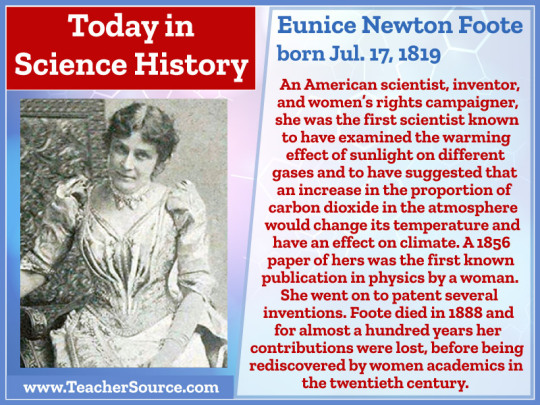
Eunice Newton Foote was born on July 17, 1819. An American scientist, inventor, and women’s rights campaigner, she was the first scientist known to have examined the warming effect of sunlight on different gases and to have suggested that an increase in the proportion of carbon dioxide in the atmosphere would change its temperature and have an effect on climate. A 1856 paper of hers was the first known publication in physics by a woman. She went on to patent several inventions. Foote died in 1888 and for almost a hundred years her contributions were lost, before being rediscovered by women academics in the twentieth century.
#eunice newton foote#climate change#greenhouse gases#carbon dioxide#women in science#women in history#science#science history#science birthdays#on this day#on this day in science history
3 notes
·
View notes
Text
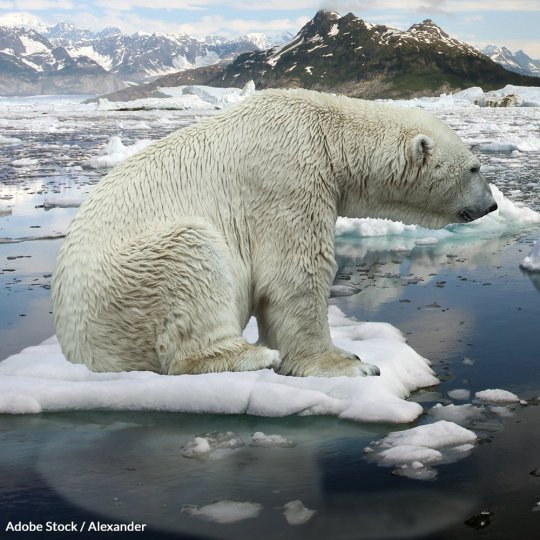
El aumento del CO2 provocará un calentamiento global.
Eunice Newton Foote, 1856
0 notes
Text
Eunice Foote: Una voz perdida en la historia del efecto invernadero. Con sus experimentos revolucionarios, ella desafió las normas de género en el siglo XIX, pero el reconocimiento le fue arrebatado.

0 notes
Text
1798: The first theory of the greenhouse effect caused by planet's atmosphere proposed.
1856: The first scientific paper stating that more CO2 would lead to a warmer earth (Eunice Newton Foote) was published.
1938: Paper, "The Artificial Production of Carbon Dioxide and Its influence on Climate" was delivered at Royal Meteorological Society. He had evidence the planet was warming.
1938: From 1908 to 1938, industry added 9,000 tons of CO2 per minute to the atmosphere. (That figure is now 77,000 tons per minute, or 110 million tons/day)
1953: increase in the frequency of tornados noticed. Continued to increase for 60 years
1955: Atlantic hurricane frequency up 50% over 2 decades
1957: Dr. Roger Revelle told a Congressional subcommittee that the Greenhouse effect might turn Texas and Southern CA into real deserts.
All data since then has only strengthened the evidence that global warming/climate change is real and accelerating.
0 notes
